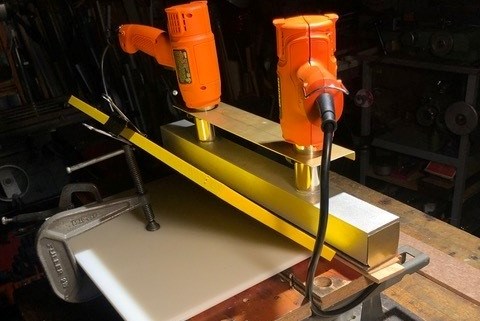Patent-pending welder rapidly melts thermoplastics
The FlatJet Welder, designed for thermoplastic components of all sizes, blasts a thin, directed jet of uniform, high-temperature air/gas for a fast, full-surface melt.

Shown here is the FlatJet Welder with two hot air guns (1,100ºF; 600ºC) set up for long, narrow, right-angle butt welding. A weld gap is exposed by tilting the yellow plate along a face-edge of the horizontal white plate. After a full-length sheet jet melts them in the gap, the yellow plate is vertically raised and forced down. Photo Credit: Winston MacKelvie
The FlatJet Welder is a patent-pending design that provides rapid surface melt to thermoplastic components, enabling quick, complete welds. Currently this is said to be a limitation to the use of thermoplastic materials, whose optimized mechanical properties but low surface energy precludes adhesive bonding. Current welding is also often limited to small areas and is a slow process.
The FlatJet Welder blasts thin, directed jets of uniform, high-temperature air/gas at tape-contact or into gaps between components of any size, rapidly liquefying the entire surface in seconds. Multiple welders may be placed around the gap to supply an unlimited and consistent heat supply.
FlatJet is available for sale and/or a joint venture. For more details and samples, contact its inventor, Winston MacKelvie, by email (winstonworks@me.com) or by phone (P: 450-243-6850, C:450-330-4293).
Related Content
-
Combining multifunctional thermoplastic composites, additive manufacturing for next-gen airframe structures
The DOMMINIO project combines AFP with 3D printed gyroid cores, embedded SHM sensors and smart materials for induction-driven disassembly of parts at end of life.
-
Plant tour: Albany Engineered Composites, Rochester, N.H., U.S.
Efficient, high-quality, well-controlled composites manufacturing at volume is the mantra for this 3D weaving specialist.
-
TU Munich develops cuboidal conformable tanks using carbon fiber composites for increased hydrogen storage
Flat tank enabling standard platform for BEV and FCEV uses thermoplastic and thermoset composites, overwrapped skeleton design in pursuit of 25% more H2 storage.













